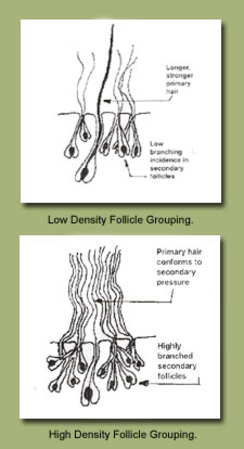|
July 05, 2012
Follicle and Fiber Types
By: Tim Sheets

This article from our Getting Started Guide discusses the importance of follicles and the corellation to fiber fineness.
Follicles are the skin structures from which the fiber grows. Alpacas have two distinct follicle types: the primary follicles and the secondary follicles. Primary follicles are the first follicles to develop in the fetus during the first three months after conception and are the focal point around which secondary follicles form at a later stage. Primary follicles produce fibers that are greater in diameter and have little or no crimp in the staple and no crinkle in the individual fiber. These are the relic of guard hairs that are seen in primitive types of alpacas as long, straight hairs that project beyond the length of the finer and softer down underneath.
Secondary follicles produce the undercoat or down of the fleece and are the softer, finer fibers that give alpaca fiber its luxury feel and improved insulation qualities. The secondary follicles develop around the primary follicles after the fourth month to create follicle groups. A higher ratio of secondary follicles to primary follicles creates finer, softer and more uniform fleeces. In huacayas, the secondary fibers create the crimp which is exhibited as waves within the staple or lock.
A subtype of the secondary follicle is called a derived secondary follicle. Fibers from derived secondary follicles exit the skin from the secondary follicles they are grouped around. They have their own follicle root and enter the follicle sheath from the side and share a common exit point from the skin. These fibers are the finest the alpaca produces and form a higher percentage in the fleece of elite alpacas. The noticeable fineness may be due to the increase pressure of several of these fibers exiting the same skin opening. This causes the fibers to not only squeeze through by becoming finer but also longer because of the squeezing action. Needless to say, these are highly desirable fibers.
A third type of fiber is called medulated fiber. Medulated fibers are course fibers that cover a range of types including solid, hollow and various grades between the two extremes. They create problems for the fiber processors in that they do not accept dye readily or uniformly thus producing variations within the yarn that make it largely unacceptable for premium markets. They present customer acceptance problems for processors because they have sharp ends which protrude from the finished product and create a prickle factor when felt against the skin. In the early days of alpaca development in the U.S., much was made of the supposed superior insulation properties of this miracle fiber with its hollow core. Alpaca fiber was touted as having 5, 8 or even 10 times the insulating qualities of even the finest wool. It is now generally thought that this claim is without merit. Hollow, medulated fibers are not desirable.
Australian fiber expert Cameron Holt describes the difference between primary and secondary follicles in this video:
|